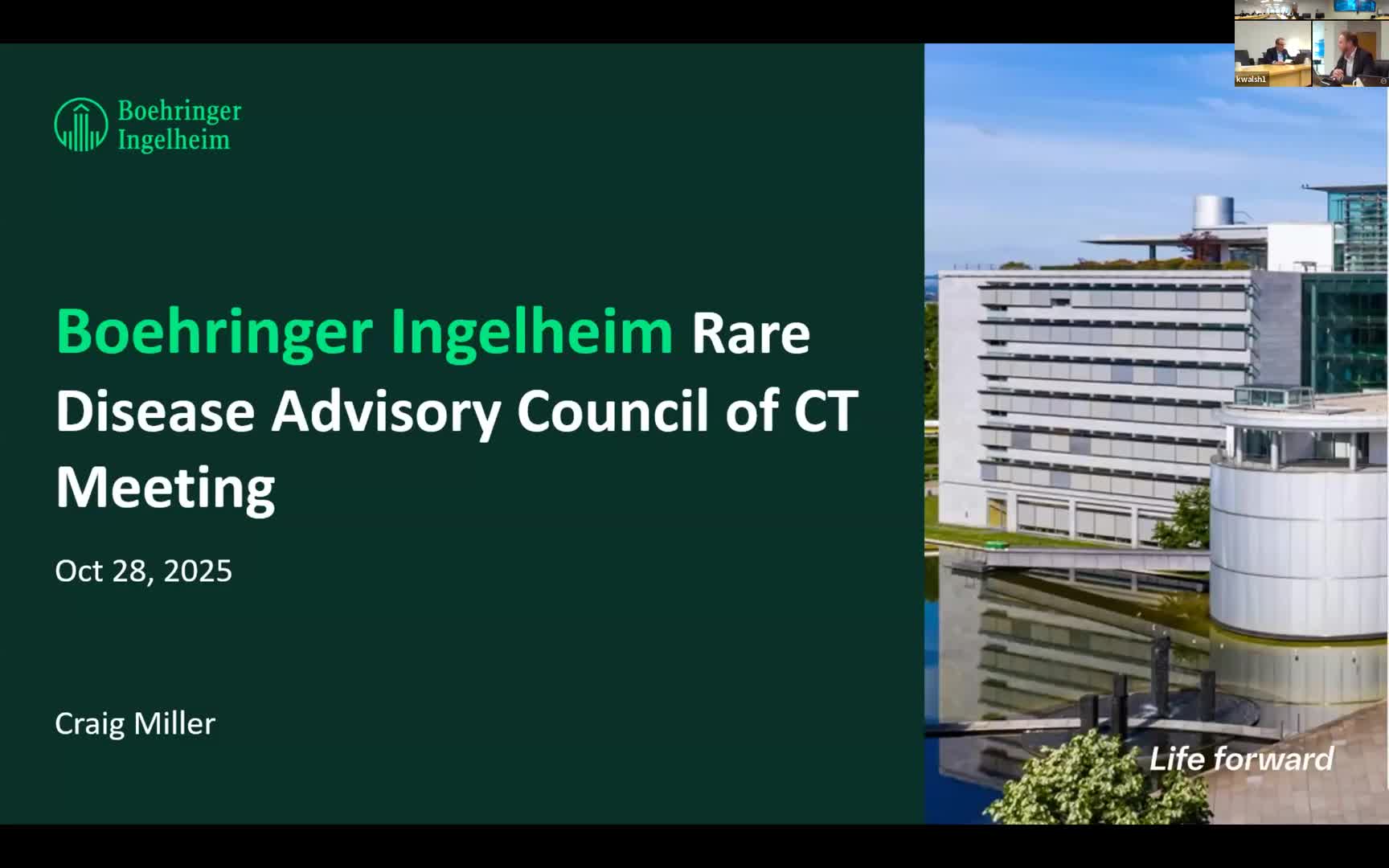Industry, researchers and advocates highlight Connecticut’s rare‑disease ecosystem; coalition warns drug‑affordability boards risk access
October 29, 2025 | Department of Public Health, Departments and Agencies, Organizations, Executive, Connecticut
This article was created by AI summarizing key points discussed. AI makes mistakes, so for full details and context, please refer to the video of the full meeting. Please report any errors so we can fix them. Report an error »

Industry, researchers and statewide advocates used the council’s public comment period to underscore Connecticut’s strengths in rare‑disease research and to flag emerging policy threats.
Craig Miller, senior director for immunology and respiratory disease research at Boehringer Ingelheim, described the company’s Connecticut presence — including its U.S. headquarters and significant R&D staff — and highlighted collaborations with Yale on systemic sclerosis and other rare conditions. Miller said the company reinvests a substantial portion of revenue into research and maintains numerous external partnerships.
Priyank Patel, a principal scientist at Boehringer Ingelheim, described spatial‑biology techniques that combine single‑cell profiling with preserved tissue context. Patel outlined how the methods allow researchers to map cell populations and molecular signals in patient tissue and presented early work on idiopathic pulmonary fibrosis and a collaboration with Yale on systemic sclerosis.
Advocacy groups and trade organizations also presented. Carrie Lotto of the Rare and Ready Coalition urged the RDAC to prepare for state actions on newborn screening and other access issues and cautioned that some state‑level Prescription Drug Affordability Boards (PDABs) in other states have produced administration costs without measurable savings for patients. “PDAB legislation is not what they had hoped it could be,” Lotto said, and she noted an example where a state removed a PDAB after concluding it did not deliver savings.
Dan Donovan of RareLife Solutions summarized a recent analysis showing rare‑disease topics make up only a small fraction of the medical literature and urged more open‑access publishing and greater inclusion of patient advocates in authorship and clinical‑trial design. BioCT (the state life‑sciences trade association) described upcoming convenings — including a legislative breakfast and a March rare‑disease summit — intended to connect legislators, patient groups and industry stakeholders.
Why it matters: Industry partnerships and novel laboratory methods can speed discovery for rare conditions, while state policy decisions (for example, how a PDAB is structured) can affect patient access and the business environment for life‑science employers in Connecticut. Advocates urged the RDAC to use its convening role to inform policymakers.
Provenance: Industry remarks and spatial biology examples appear in the transcript at timecode blocks 2933.90–3188.76 (Boehringer Ingelheim overview) and 5865.54–6294.40 (spatial biology). Rare and Ready coalition remarks and PDAB warnings are at 3352.725–4254.11.
Craig Miller, senior director for immunology and respiratory disease research at Boehringer Ingelheim, described the company’s Connecticut presence — including its U.S. headquarters and significant R&D staff — and highlighted collaborations with Yale on systemic sclerosis and other rare conditions. Miller said the company reinvests a substantial portion of revenue into research and maintains numerous external partnerships.
Priyank Patel, a principal scientist at Boehringer Ingelheim, described spatial‑biology techniques that combine single‑cell profiling with preserved tissue context. Patel outlined how the methods allow researchers to map cell populations and molecular signals in patient tissue and presented early work on idiopathic pulmonary fibrosis and a collaboration with Yale on systemic sclerosis.
Advocacy groups and trade organizations also presented. Carrie Lotto of the Rare and Ready Coalition urged the RDAC to prepare for state actions on newborn screening and other access issues and cautioned that some state‑level Prescription Drug Affordability Boards (PDABs) in other states have produced administration costs without measurable savings for patients. “PDAB legislation is not what they had hoped it could be,” Lotto said, and she noted an example where a state removed a PDAB after concluding it did not deliver savings.
Dan Donovan of RareLife Solutions summarized a recent analysis showing rare‑disease topics make up only a small fraction of the medical literature and urged more open‑access publishing and greater inclusion of patient advocates in authorship and clinical‑trial design. BioCT (the state life‑sciences trade association) described upcoming convenings — including a legislative breakfast and a March rare‑disease summit — intended to connect legislators, patient groups and industry stakeholders.
Why it matters: Industry partnerships and novel laboratory methods can speed discovery for rare conditions, while state policy decisions (for example, how a PDAB is structured) can affect patient access and the business environment for life‑science employers in Connecticut. Advocates urged the RDAC to use its convening role to inform policymakers.
Provenance: Industry remarks and spatial biology examples appear in the transcript at timecode blocks 2933.90–3188.76 (Boehringer Ingelheim overview) and 5865.54–6294.40 (spatial biology). Rare and Ready coalition remarks and PDAB warnings are at 3352.725–4254.11.
View the Full Meeting & All Its Details
This article offers just a summary. Unlock complete video, transcripts, and insights as a Founder Member.
✓
Watch full, unedited meeting videos
✓
Search every word spoken in unlimited transcripts
✓
AI summaries & real-time alerts (all government levels)
✓
Permanent access to expanding government content
30-day money-back guarantee

